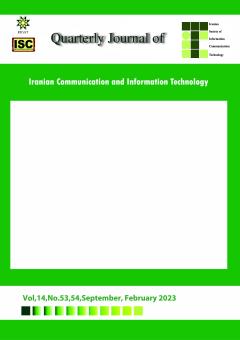Improving polarity identification in sentiment analysis using sarcasm detection and machine learning algorithms in Persian tweets
Subject Areas : ICTShaghayegh hajiabdollah 1 , Mitra Mirzarezaee 2 , Mir Mohsen Pedram 3
1 - -
2 -
3 -
Keywords: Sentiment analysis, opinion mining, sarcasm detection, twitter, ensemble learning,
Abstract :
Sentiment analysis is a branch of computer science and natural language processing that seeks to familiarize machines with human emotions and make them recognizable. Both sentiment analysis and sarcasm which is a sub-field of the former, seek to correctly identify the hidden positive and negative emotions of the text. The use of sarcasm on social media, where criticism can be exercised within the context of humor, is quite common. Detection of sarcasm has a special effect on correctly recognizing the polarization of an opinion, and thus not only it can help the machine to understand the text better, but also makes it possible for the respective author to get his message across more clearly. For this purpose, 8000 Persian tweets that have emotional labels and examined for the presence or absence of sarcasm have been used. The innovation of this research is in extracting keywords from sarcastic sentences. In this research, a separate classifier has been trained to identify irony of the text. The output of this classifier is provided as an added feature to the text recognition classifier. In addition to other keywords extracted from the text, emoticons and hashtags have also been used as features. Naive Bayes, support vector machines, and neural networks were used as baseline classifiers, and finally the combination of classifiers was used to identify the feeling of the text. The results of this study show that identifying the irony in the text and using it to identify emotions increases the accuracy of the results.
[1]. Pang, B., Lee, L., & Vaithyanathan, S. (2002). Thumbs up: sentiment classification using machine learning techniques. In Proceedings of the Conference on Empirical Methods in Natural Language Processing, (pp. 79–86)
[2]. Ravi, K., & Ravi, V. (2015). A survey on opinion mining and sentiment analysis: tasks, approaches and applications. Knowledge-based systems, 89, 14-46.
[3]. Wandra, K. H., & Barot, M. SARCASM DETECTION IN SENTIMENT ANALYSIS.
[4]. Dashtipour, K., Hussain, A., Zhou, Q., Gelbukh, A., Hawalah, A. Y., & Cambria, E. (2016, November). PerSent: a freely available Persian sentiment lexicon. In International Conference on Brain Inspired Cognitive Systems (pp. 310-320). Springer, Cham.
[5]. [4] Hardeniya, T., & Borikar, D. A. (2016). Dictionary based approach to sentiment analysis-a review. International Journal of Advanced Engineering, Management and Science, 2(5), 239438.
[6]. Khan, A., Baharudin, B., Lee, L. H., & Khan, K. (2010). A review of machine learning algorithms for text-documents classification. Journal of advances in information technology, 1(1), 4-20.
[7]. Wilson, T., Wiebe, J., & Hoffmann, P. (2005, October). Recognizing contextual polarity in phrase-level sentiment analysis. In Proceedings of human language technology conference and conference on empirical methods in natural language processing (pp. 347-354).
[8]. Wu, H. H., CHARNG-RURNG TSAI, A. N. G. E. L. A., TZONG-HAN TSAIi, R. I. C. H. A. R. D., & YUNG-JEN HSU, J. A. N. E. (2013). Building a Graded Chinese Sentiment Dictionary Based on Commonsense Knowledge for Sentiment Analysis of Song Lyrics. Journal of Information Science & Engineering, 29(4).
[9]. Shams, M., Shakery, A., & Faili, H. (2012, May). A non-parametric LDA-based induction method for sentiment analysis. In The 16th CSI international symposium on artificial intelligence and signal processing (AISP 2012) (pp. 216-221). IEEE.
[10]. Basiri, M. E., Naghsh-Nilchi, A. R., & Ghasem-Aghaee, N. (2014). Sentiment prediction based on dempster-shafer theory of evidence. Mathematical Problems in Engineering, 2014.
[11]. Dashtipour, K., Gogate, M., Adeel, A., Hussain, A., Alqarafi, A., & Durrani, T. (2017, July). A comparative study of persian sentiment analysis based on different feature combinations. In International Conference in Communications, Signal Processing, and Systems (pp. 2288-2294). Springer, Singapore
[12]. Heikal, M., Torki, M., & El-Makky, N. (2018). Sentiment analysis of Arabic Tweets using deep learning. Procedia Computer Science, 142, 114-122.
[13]. Rahimi, Z., Noferesti, S., & Shamsfard, M. (2019). Applying data mining and machine learning techniques for sentiment shifter identification. Language Resources and Evaluation, 53(2), 279-302.
[14]. Dashtipour, K., Gogate, M., Adeel, A., Ieracitano, C., Larijani, H., & Hussain, A. (2018, July). Exploiting deep learning for Persian sentiment analysis. In International conference on brain inspired cognitive systems (pp. 597-604). Springer, Cham.
[15]. Alharbi, A. S. M., & de Doncker, E. (2019). Twitter sentiment analysis with a deep neural network: An enhanced approach using user behavioral information. Cognitive Systems Research, 54, 50-61.
[16]. Prasad, A. G., Sanjana, S., Bhat, S. M., & Harish, B. S. (2017, October). Sentiment analysis for sarcasm detection on streaming short text data. In 2017 2nd International Conference on Knowledge Engineering and Applications (ICKEA) (pp. 1-5). IEEE.
[17]. Ren, Y., Ji, D., & Ren, H. (2018). Context-augmented convolutional neural networks for twitter sarcasm detection. Neurocomputing, 308, 1-7.
[18]. Mehndiratta, P., Sachdeva, S., & Soni, D. (2017). Detection of sarcasm in text data using deep convolutional neural networks. Scalable Computing: Practice and Experience, 18(3), 219-228.
[19]. Ahuja, R., Bansal, S., Prakash, S., Venkataraman, K., & Banga, A. (2018). Comparative study of different sarcasm detection algorithms based on behavioral approach. Procedia computer science, 143, 411-418.
Rohanian, Morteza & Salehi, Mostafa & Darzi, Ali & Ranjbar, Vahid. (2020). Convolutional Neural Networks for Sentiment Analysis in Persian Social Media.


